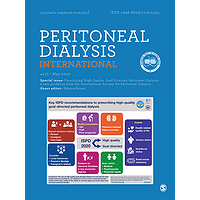Background: Peritonitis is one of the most common complications of peritoneal dialysis (PD). Understanding the risk factors of peritonitis in a multi-racial Asian population may help to improve outcomes on PD.Methods: We conducted a prospective observational study to identify risk factors for PD-related peritonitis over a 1-year period in 15 adult PD centers. All peritonitis episodes were independently adjudicated.Results: A total of 1,603 participants with a mean age of 51.6 years comprising 52.7% females, 62.6% ethnic Malays, 27.0% Chinese, and 8.1% Indians were recruited. The overall peritonitis rate was 1 episode per 44.0 patient-months with 354 episodes recorded in 282 (17.6%) patients over 15,588 patient-months. Significant risk factors of peritonitis were severe obesity (incidence-rate ratio [IRR] 3.32, 95% confidence interval [CI]: 1.30, 8.45), hypoalbuminemia (IRR 1.61, 95% CI: 1.06, 2.46), Staphylococcus aureus nasal carriage (IRR 2.26, 95% CI: 1.46, 3.50), and use of Fresenius system (Fresenius Medical Care North America, Waltham, MA, USA) (IRR 2.49, 95% CI: 1.27, 4.89). The risk of peritonitis was lower in those on automated PD compared with standard PD (IRR 0.43, 95% CI: 0.25, 0.74), and in centers with a patient-staff ratio of 15 to 29.9 (IRR 0.67, 95% CI: 0.49, 0.90) and >= 30 (IRR 0.52, 95% CI: 0.34, 0.80). Prevalent patients and exit-site care with topical antibiotics were also protective against peritonitis. Peritonitis rates varied between racial groups. The IRRs of overall peritonitis and grampositive peritonitis in Chinese versus other racial groups were 0.65 (95% CI: 0.46, 0.90) and 0.47 (95% CI: 0.24, 0.91), respectively.Conclusions: Multiple patient, center, and PD-system factors influence the risk of peritonitis. In the Asian population, there are racial differences in the risk of peritonitis.

RISK OF PERITONEAL DIALYSIS-RELATED PERITONITIS IN A MULTI-RACIAL ASIAN POPULATION
Review badges
Identifiers
RISK OF PERITONEAL DIALYSIS-RELATED PERITONITIS IN A MULTI-RACIAL ASIAN POPULATION
Published in Peritoneal Dialysis International on January 02, 2017
Web of Science (Free Access)
Abstract
Authors
Ong, Loke Meng; Ch'ng, Chin Chin; Wee, Hong Chin; Supramaniam, Premaa; Zainal, Hadzlinda; Goh, Bak Leong; Bavanandan, Sunita; Mushahar, Lily; Hooi, Lai Seong; Ahmad, Ghazali
Publons users who've claimed - I am an author
Contributors on Publons
- 3 authors
- 1 reviewer
- Contribute
- All peer review content displayed here is covered by a Creative Commons CC BY 4.0 license.Post-publication review Mar 2017
The issue with ethnic difference in peritoneal dialysis outcomes is controversial but plausible, and so this study is an important one.
This is an observational study derived from a population-based registry in Malaysia. Specifically, the manuscript mentioned the National Renal Registry database (page 4) and we assume that as the source of data in this study. The population refers to 1986 (mostly prevalent) peritoneal dialysis patients from 15 adult and 5 pediatric centres. The study objective is to look for risk factors of peritonitis and the authors highlight the uniqueness of studying multi-racial Asian population. Multivariate analysis showed that race, severe obesity (body mass index ≥ 35), Staphylococcus aureus nasal carriage, hypoalbuminaemia (first serum albumin < 30 g/L) and distance from home to dialysis centres were independently predictive of peritonitis. Remarkably, Staphylococcus aureus peritonitis rate was significantly lower among Chinese subjects.
Can we be sure that there isn't chance for selection bias? In other words, could those who are at higher risk of peritonitis preferentially treated with peritoneal dialysis (and thus overrepresentation) in races other than Chinese? First, the income status (Table 2) showed a more economically advantageous group among Chinese patients. Could there be a tendency for the Chinese to receive better care? Second, was there chance for language barrier to hinder the peritoneal dialysis training and treatment education in the minority group? Third, and of prime interest, was there difference in centre size (say, larger peritoneal dialysis centres for Chinese patients)? Centre effect needs to be taken into consideration because dialysis centres with less than 40 peritoneal dialysis patients had been shown to be an independent factor associated with the risk for the first peritonitis in Brazil (Martin LC et al. Clin J Am Soc Nephrol 2011). In a previous analysis (Fang W et al. Nephrol Dial Transplant 2008), comparison was made between 256 Canadian and 240 Chinese incident peritoneal dialysis; a remarkably (and statistically significant) lower peritonitis rate was demonstrated among Chinese dialysis patients (one episode every 60.6 versus one in every 36.1 patient-months). The reported peritonitis rate is pretty close to that reported among Chinese patients in your study, with one episode every 51.8 patient-months. Interestingly, another study by Blake PG et al (Am J Kidney Dis 2000) showed a significantly better self-reported compliance with continuous ambulatory peritoneal dialysis among Asians than Hispanics and black. That is another important point of note.
Published inReviewed by




